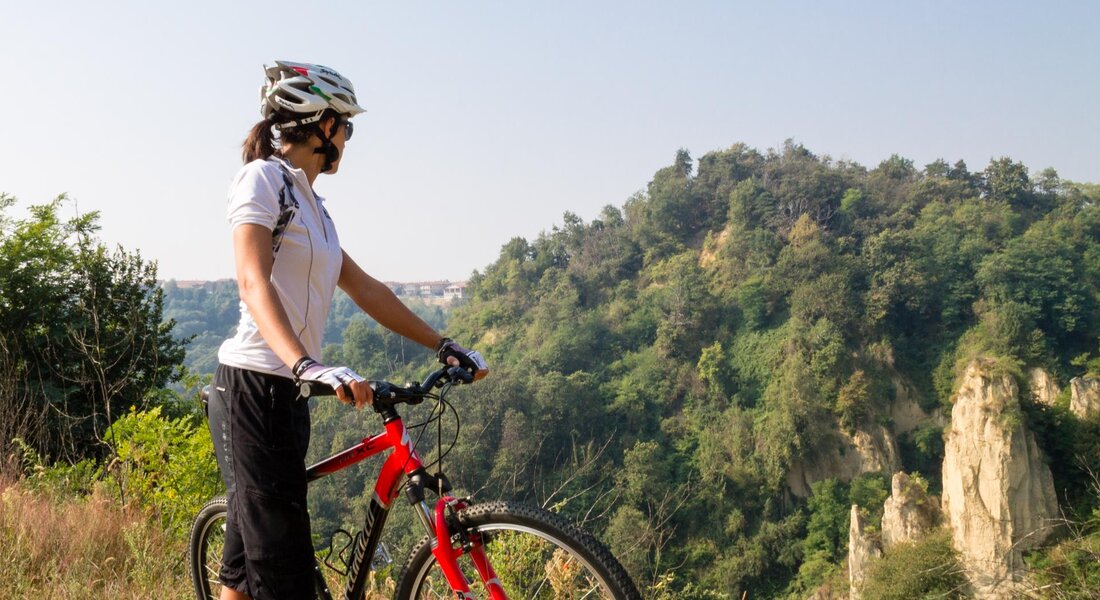Start from Vecchia Segheria, home to the Ecomuseo delle Rocche del Roero, which is open for information on trails and outings in the area.
Here, the itinerary coincides with the “Grande Sentiero del Roero” (Trail S1), the signposts of which may be followed as a guide. Follow along Via Cavour, the main street of town, past Piazza San Michele, where you will find the Town Hall. Continue along the first section of Via Roma, then turn onto Via Maccallè, which heads slightly downhill.
The itinerary continues winding along the base of this damp valley as it follows the Rio Canneto through lush habitats for truffles and the occasional muddy stretch where rain water tends to gather. The trail then heads back up through hillside vineyards with a final steep section of climb to the last few hexagonal chapels of the Stations of the Cross of Santuario dei Piloni, which was a place of pagan worship during the pre- Roman era before being converted to use by Christians. It is an evocative setting with a 360° view of the surrounding hills and is certainly worth a leisurely visit. The chapels, records of which date back to 1774 and which were rebuilt in their current hexagonal shape in 1897, contain groups of statues depicting scenes from the Passion of Christ. By taking a brief detour along the “Sentiero Religioso” (Religious Trail), you will reach the Church of SS. Giacomo e Filippo Minore, which features two marble heads from the late-Roman era and the remains of brickwork from the 13th century.
Returning to the main itinerary, stay along the crest of the hill in the direction of Santo Stefano Roero as you enjoy, to your left, a panorama of untamed, natural amphitheaters of cliffs and other rock formations. You will also note the typical flora found on Roero hilltops, including chestnut trees, Scots pine, and steep hillside vineyards. The Rocche rock formations are a constant feature of this section of the itinerary and throughout the “Grande Sentiero del Roero”, a trail that crosses the sandy landscapes of this geological phenomenon that extends for over 40 kilometres (25 miles). The origin of these rock formations dates back some 250,000 years ago and certain geological changes to the area due to erosion caused by a phenomenon known as the “Capture of the Tanaro”. The Tanaro river originally flowed from south to north, reaching the Po river near Carmagnola. As a result of erosion caused by another river, the Tanaro changed course and began flowing towards Alba, hence the “capture” of the Tanaro river, which caused great changes to the soil in the valleys affected. The streams and rivers of the Roero area began shifting towards the new Tanaro Valley, carving deep gorges and picturesque ravines into the sandy soil. The tributaries inherited by the former watershed adapted to this new situation and the result of all this was truly unique; cliffs and spires, fossils and pyramids of yellow sand can still be seen amid the rolling Roero hills, which are so fragile that landslides and mudslides continue to alter the landscape from one year to the next.
Once at Bricco Bissoca, at an altitude of 405 metres (1,330 ft) where you will find an impressive, cylindrical aqueduct, the trail begins to fall steeply back down the hill with a stunning view of the village of Santo Stefano Roero. When you reach Piazza Santa Maria del Podio, with its characteristic ridge of rock decorating the square, you can take a break here or in the local trattoria, or you can continue the itinerary along highway SP 110. Continue alongside the town cemetery, then turn left in the direction of Carretta. On March 8, 1945, this tiny hamlet was the site of a victorious battle of the resistance fighters, who had a base here, against Fascist troops returning to Turin after several days of violent skirmishes in Cisterna d’Asti. It is said that so many shots were fired on that day that the trunks of the large chestnut trees alongside the road here are still riddled with bullets.
After climbing past the homes in Carretta, the trail winds down through the cool of old-growth chestnut trees, crosses the “Sentiero della Castagna Granda”, (Big Chestnut Trail) and reaches the hamlet of Lambi, where you will find a breathtaking view of the medieval Monteu Roero Castle overlooking the valley of pristine woodlands. It is an image from another time, one that evokes stories of the robbers and bandits who, in the 19th century, sought escape routes along these isolated trails, such as the infamously ferocious Delpero, who once terrorized this area.
Once back on the asphalt, continue in the direction of Monteu Roero. When you reach highway SP 29 at the entrance to the village, turn immediately right towards the cemetery.
PLEASE NOTE: Responsibility for the maintenance and practicability of the various trails lies with the municipalities where the routes are located. The Tourist Board, therefore, cannot be held responsible for any inefficiencies, but is willingly available to collect your reports so that they can be forwarded to the authorities concerned.


